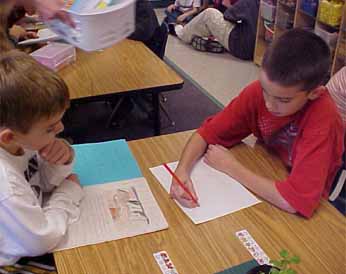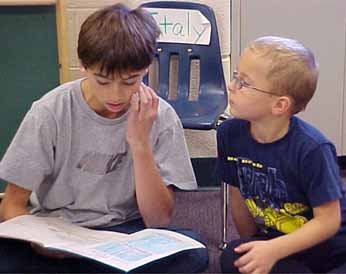The 7th Graders have completed the first of two
Book Projects. Our first book was entitled "The Atmosphere of Our
Planet Earth." Here is the outline that students used to create
their book.
Exploring Planet Earth Book
Part
One – Chapter One
Apply the following steps to create your book.
You will be graded on content, neatness/clarity and the ability to
following instructions.
COVER:
Title: The
Atmosphere of Our Planet Earth
-
Draw
the planet Earth
INSIDE COVER:
By: _________________
Published Date:
______________
Page #1: Title: The Past Atmosphere
-
Draw what
scientists feel the earth looked like many years ago.
-
(Restate) What two
gases were present in the greatest amount in the atmosphere of the
Earth 4 billion years ago?
Page #2: Title: The Atmosphere Today
-
Draw Figure 1-7 (Prentice
Hall publication ISBN#0-13-423187-2)
-
(Restate) What
four gases are present in the greatest amounts in the Earth’s
atmosphere today?
Pages 3 and 4:
Title: The Nitrogen Cycle
-
Draw the nitrogen
cycle
-
(Restate)
Describe the process of the nitrogen cycle by using the following
terms: nitrogen, proteins, muscles, growth, repair,
nitrogen-fixing bacteria, nitrates, plants, decay.
-
(Restate)
Define the nitrogen cycle in one sentence.
Page #5: Title: Oxygen
in the Atmosphere
-
Draw a pie chart
to show the amount of oxygen in the Earth’s atmosphere.
-
(Restate) Which
two gases make up most of the Earth’s atmosphere?
Pages 6 and 7:
Title: The Carbon Cycle
-
Draw the Carbon
Cycle in Figure 1-12
-
Describe how
carbon dioxide and oxygen are continuously exchanged among plants
and animals by using the following terms: carbon dioxide, oxygen,
green plants, photosynthesis, respiration, decay.
-
(Restate) Why are
scientists concerned that the level of carbon dioxide in the air
is increasing?
Pages 8 and 9:
Title: The Water Cycle
-
Draw the Water
Cycle
-
(Restate) Describe
the steps of the water cycle by using the following terms:
evaporation, condensation, precipitation, rain, runoff, sleet,
water vapor, snow, hail.
Page #10: Title: Pollution
of the Atmosphere
-
Draw an example of
a source of pollution to the atmosphere.
-
(Restate) Describe
two suggestions that you and your family can do to reduce the
amount of air pollution.
Page #11: Title: Layers of the Atmosphere
-
Draw the planet
Earth and the atmosphere that surrounds it.
-
(Restate)
How are the layers of the atmosphere divided?
-
(Restate) Describe
how air pressure changes as altitude increases.
Page #12: Title: The Troposphere
-
Draw land along
the bottom of the page. Illustrate the layer of the atmosphere
closest to the Earth by drawing and labeling (average height) a
line to indicate the height above the Earth.
-
Draw examples of
two significant characteristics of the troposphere.
-
(Restate) Describe
how convection currents contribute to the Earth’s weather.
-
(Restate)
Describe the temperature with increase in altitude.
Page #13: Title: The Stratosphere
-
Draw land along
the bottom of the page. Draw a line and label average height of
the troposphere. Illustrate this layer of the atmosphere by
drawing and labeling (height) a line above the surface of the
Earth.
-
(Restate) Describe
the temperature with increase in altitude.
-
Draw a significant
characteristic of this layer of the atmosphere that helps move
weather patterns from west to east across the United States.
-
Draw the ozone molecule; Figure 1-19.
-
(Restate) Explain
why the ozone layer is important to life on Earth.
Page #14: Title: The Mesosphere
-
Draw land along
the bottom of the page. Draw a line and label average height of
the troposphere. Draw another line and label the height of the
stratosphere. Illustrate this layer of the atmosphere by drawing
and labeling (height) a line above the surface of the Earth.
-
(Restate) Describe
the temperature with increase in altitude.
-
Draw a significant
characteristic of this layer of the atmosphere.
-
(Restate) Describe
how the significant characteristic you drew in number three is
important to life on Earth.
Page #15: Title: The Thermosphere
-
Draw
land along the bottom of the page. Draw a line and label average
height of the troposphere. Draw another line and label the height
of the stratosphere. Draw a third line and label the height of the
Mesosphere. Illustrate this layer of the atmosphere by labeling
the lower and upper levels of the thermosphere.
-
(Restate) Why is
the temperature not measured with a thermometer?
-
Draw a significant
characteristic of this layer of the atmosphere.
-
(Restate) Explain why a solar flare may interfere with the
transmission of radio waves in the ionosphere.
Page #16: Title: The Magnetosphere
1. Draw and label
the parts of the magnetosphere; Figure 1-25.
3.
(Restate) Why does the magnetosphere formed by the Earth extend
farther on one side than the other?
4.
(Restate) How do scientists predict when an aurora will be visible?










